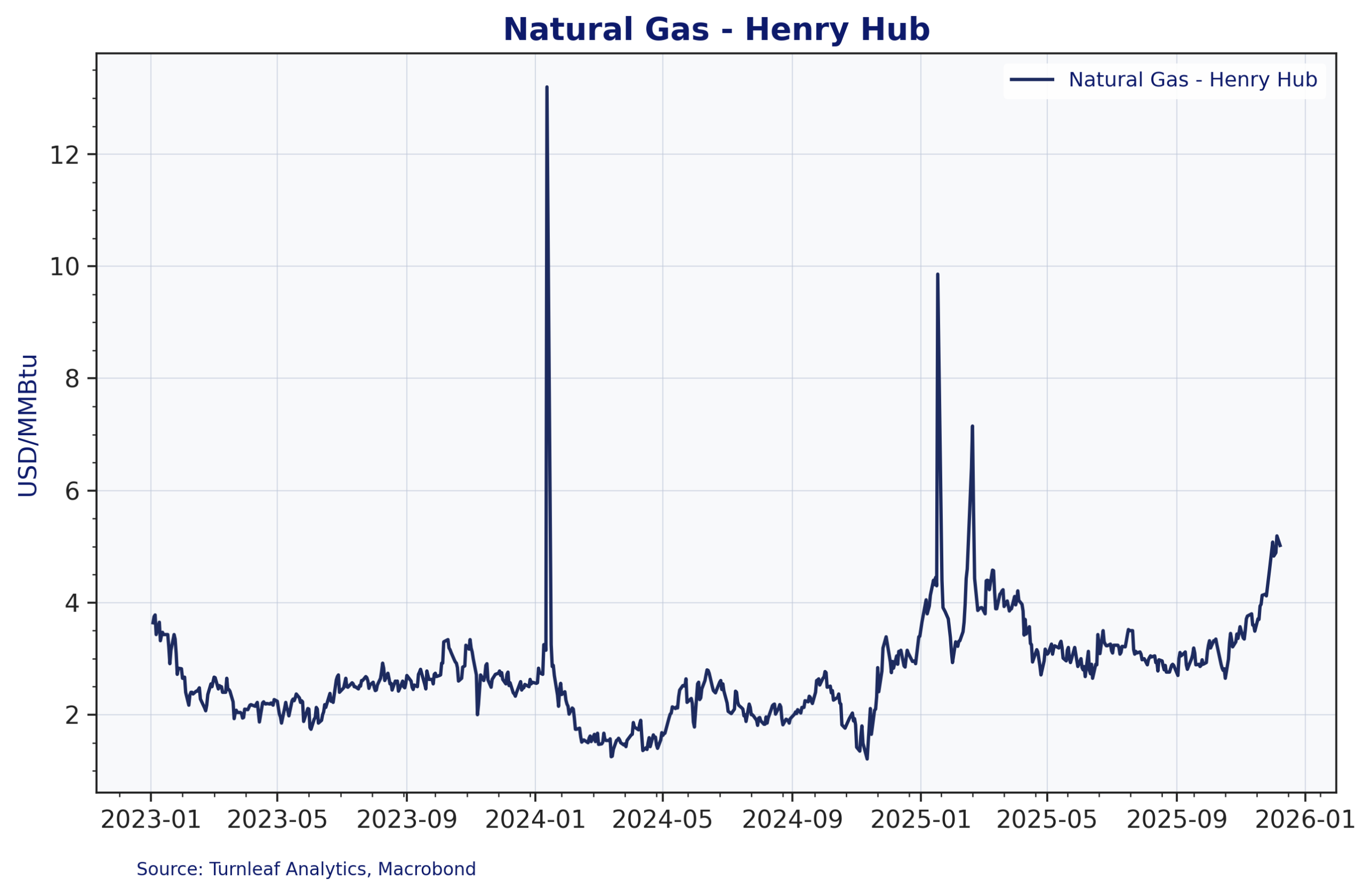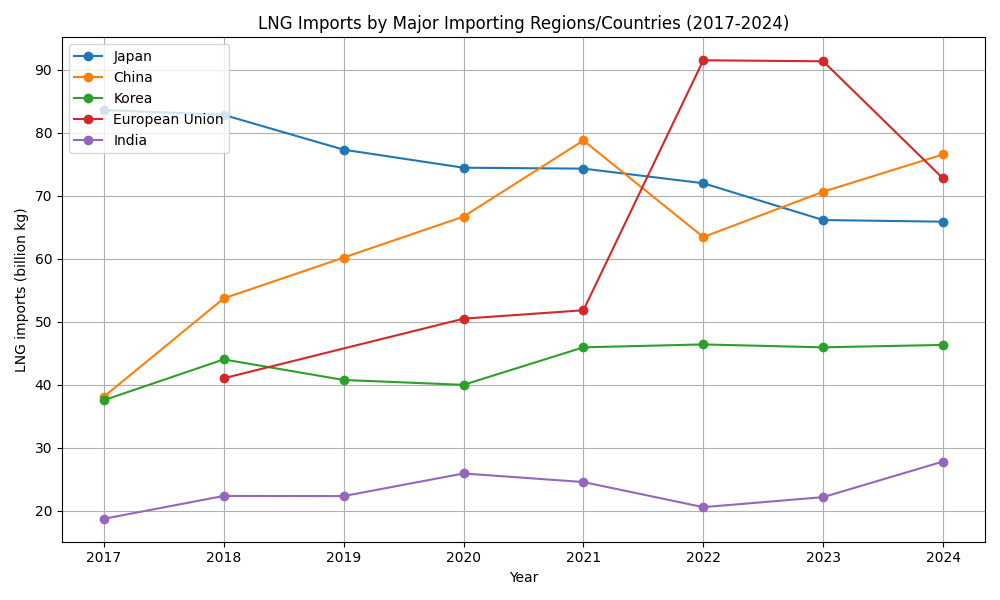Featured Research
Macroeconomic Insights: US CPI – Natural Gas Price Dynamics and Inflation Pass-Through
The recent spike in natural gas futures reflects market expectations of future supply constraints. Unlike past volatility driven by weather alone, this increase stems from structural imbalance like growing LNG exports, surging electricity demand (especially from data...
Macroeconomic Insights: US CPI – Natural Gas Price Dynamics and Inflation Pass-Through
The recent spike in natural gas futures reflects market expectations of future supply constraints. Unlike past volatility driven by weather alone, this increase stems from structural imbalance like growing LNG exports, surging electricity demand (especially from data centers), and production growth that is not keeping pace. In early December Henry Hub spot prices were close to 4.9 dollars per MMBtu and near-term futures were around 5 dollars, the highest level since December 2022 (EIA Weekly, Dec 4) (Figure 1). This futures curve shift raises utilities’ expected fuel costs, which will eventually pass into regulated gas and electricity tariffs. Turnleaf’s model responds to these regulated tariff adjustments rather than daily spot market moves, meaning the inflationary signal from the futures market appears with a lag.
Figure 1

Three major drivers underpin this upward movement in prices:
1. Rising LNG Exports – As new LNG export terminals come online, growing overseas demand, particularly from Europe, is drawing an increasing share of US natural gas into global markets, placing additional upward pressure on domestic prices (Figure 2).
Figure 2

By late 2026, LNG exports are projected to add approximately 2.1 billion cubic feet per day of incremental demand, further tightening the domestic supply–demand balance (Figure 3).
Figure 3

2. Flat Production Growth – While US natural gas production is projected to increase modestly (~1% YoY in 2026), it fails to match the accelerating demand from both exports and power generation.
3. Weather & Storage – Colder-than-expected December temperatures pushed the EIA’s winter forecast up by $0.40/MMBtu. While storage entered winter 4% above the five-year average, withdrawals in December are expected to be 28% above normal, reinforcing near-term tightness.
Figure 4 shows how this imbalance is starting to reach households. US natural gas production grows only modestly through 2024 and is about 5 percent higher YoY by late 2025, while the household gas and electricity price index moves from a 10% decline in early 2024 to gains above 15% by autumn 2025. The growing gap between weak supply growth and rising household prices reflects stronger demand from LNG exports and the power sector, and the way regulated fuel-cost mechanisms pass higher wholesale prices into retail tariffs with a delay rather than in one step.
Figure 4

Natural gas supplied about 43 percent of US electricity in 2024 and remains the dominant fuel (Ember 2025). Figure 5 shows the changing generation mix. Solar output rose 27 percent and wind generation grew 7 percent, together reaching a record 17 percent share of total generation, while coal fell to a historic low of 15 percent. Even with strong growth in renewables, gas-fired generation still increased 3.3 percent because overall electricity demand expanded, which kept gas in the marginal price-setting role.
Figure 5

This demand-supply gap is also passed through to consumers via regulated utility mechanisms with natural gas prices feeding directly into electricity rates. Since utilities hedge fuel costs through futures, rising forward prices push expected costs higher, and these eventually flow into retail tariffs as state regulators revise fuel-cost allowances. The lag here is usually 6–18 months for gas, and 3–12 months for electricity.
Electricity demand rose by about 3% in 2024, ending over a decade of stagnation. This shift is largely driven by data centers, which consumed around 4% of total US electricity use. With demand from AI-driven workloads expected to grow rapidly, monitoring the Data Processing PPI will be increasingly important, particularly following the cancellation of the October 2025 release.
Electricity has a much larger weight in the CPI basket (2.0–2.5%) compared to utility gas (0.7–0.8%). Since gas-fired plants often set marginal power prices, higher gas futures are rapidly transmitted to electricity tariffs, amplifying the inflationary impact. Turnleaf’s model already detects this pressure in electricity pricing, keeping inflation fluctuating around 3%YoY into 2026.
Natural gas futures are likely to influence CPI through both utility gas and electricity channels. While gas tariff adjustments take longer, electricity prices react more quickly due to their dependence on marginal gas costs. With Henry Hub prices expected to remain elevated into late 2026, upward pressure on energy-services inflation is likely to intensify over the next year. The sustained rise in electricity prices and demand flagged by Turnleaf’s CPI YoY NSA daily model is an early warning. If natural gas prices remain persistently high or continue to climb, a likely adjustment of the forecast should be expected along with broader inflation pass-through by mid to late 2026.
To check out Turnleaf’s US CPI 12-month forecast, visit our Substack here.
Research Archive
Macroeconomic Insights: US CPI – Natural Gas Price Dynamics and Inflation Pass-Through
The recent spike in natural gas futures reflects market expectations of future supply constraints. Unlike past volatility driven by weather alone, this increase stems from...
Macroeconomic Insights: Switzerland CPI – Inflation Not Hot Not Cold
Last month Turnleaf argued that Switzerland was escaping deflation but still stuck near 0% inflation over the next year, with any firming coming mainly from tax changes and...
Macroeconomic Insights: Australia Inflation Sparks Concern
Reaching 3.8% YoY in October 2025, headline CPI is currently above both the RBA's 2–3% target band and the market consensus forecast of 3.6% (ABS CPI October 2025). Turnleaf's...
Macroeconomic Insights: India CPI – Structural Pressures Emerge
In the past month Turnleaf's 12-month inflation forecast for India has edged lower as the pace of food and energy price increases slowed. This moderation reflects seasonal...
QuantMinds London 2025
"Are you on mute?" is perhaps the most succinct catchphrase which most comprehensively describes the post-covid landscape of work. Yet, despite the plethora of video conferencing...
Macroeconomic Insights: Gilt Selloff, Autumn 2026 Budget
The Autumn 2025 Budget, scheduled for 26 November, is expected to deliver substantial fiscal tightening. Independent forecasts estimate a tax-raising package in the region of...
Macroeconomic Insights: US CPI — Shutdown Distortions Shift the Focus to November
The 43-day U.S. government shutdown has materially degraded the quality of October’s inflation data. With BLS field operations suspended for the duration of the collection...
What would you have said?
I recently went back to Imperial College. Whilst, I've been back many times since I graduated, this was the first time that I was returning to stand in front of an audience to...
Macroeconomic Insights: Norway CPI – Hey It’s Okay, Mistakes Happen
The Norway Statistical Institute recently revised the latest CPI print from 3.3% to 3.1%, correcting an error in electricity-price calculations that overstated inflation. Despite...
Macroeconomic Insights: Abu Dhabi GDP Forecast
Turnleaf expects Abu Dhabi GDP growth to slow to 2-3%YoY in the next two quarters before hitting 7%YoY in 2026Q1 and then falling back to a bit over 3%YoY by June 2026 (Figure...
Macroeconomic Insights: Switzerland CPI – Escaping Deflation
Turnleaf expects Switzerland inflation to oscillate around 0% over the next 12 months with some indication of healthy price growth towards the tail-end of our forecast (Figure 1...
Macroeconomic Insights: Japan CPI – Nigiri Sushi Inflation
As of September 2025, Japan's inflation profile remains dominated by food price dynamics. The headline 2.9% YoY reading reflects a disproportionate rice contribution—despite...
U.S. Government Shutdown and the October 2025 CPI Print
The BLS released the September 2025 CPI print on October 24, nine days after its originally scheduled October 15 release date, following a partial recall of staff during the...
Quant Strats London 2025
Quant Strats has been a feature of the quant calendar for a number of years. I went to my first event recently after a couple of years. The event has evolved somewhat over time,...
Macroeconomic Insights: Brazil CPI — Food Costs, Currency Dynamics, and the Path to 4%
Brazilian inflation has proved particularly sticky, driven by persistent wage growth, global trade dynamics, and elevated food inflation from weather-related supply constraints....